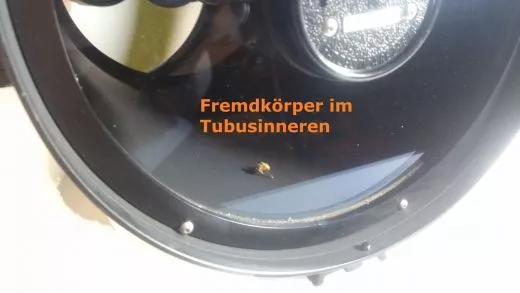- Details
- More images
Products description
Foreign body removal: A Celestron C8 has landed on the bee...
Problem:
A customer's older Celestron C8 SC acquired an involuntary roommate, a bee.
Unfortunately, the creature couldn't get out and ended up inside the tube. Since bees (like wasps and flies) become brittle over time and with movement and disintegrate into individual pieces, the risk increases that these pieces will stick to mirrors or Schmidt plates and begin to interfere with the optics.
During the routine inspection of the telescope, numerous metal shavings were also noticed behind and around the Schmidt plate, which had also accumulated inside.
Solution:
Unfortunately, neither the bee nor the shavings could be removed without removing the Schmidt plate.
CAUTION: If a Schmidt plate needs to be removed from an SC, it is essential to wear gloves. This is the only way to avoid accidental contamination of the plate. Skin oils literally "burn" into the coatings of glass.
Also, be sure to pay attention to the markings on the plate. Older models were individually ground, meaning the plate and the rest of the optics are matched. Therefore, the plate MUST be returned to exactly the same position. Blue markings and/or small engraving marks are often found at 3 o'clock and 12 o'clock. It's best to take a photo of the original position.
After removing the Schmidt plate, the bee was removed with tweezers, and the metal shavings were removed from and inside the tube with a fine brush. Small residue from the Schmidt plate itself could easily be removed with a blower.
CAUTION: Never blow your breath over the glass plate. Tiny droplets of saliva act just like skin oils and "burn" into the coating.
When inserting the Schmidt plate, we replaced the (non-original) paper scraps (originally cork pieces) with small rubber grips and paid close attention to ensuring that the plate was not under tension.
The telescope's final adjustment was then completed, which simultaneously completes and tests the repair.
A word about cleaning Schmidt plates:
A Schmidt plate rarely needs cleaning. Dust particles or small streaks do not affect the optics!
The glass surface of the plate is coated! This coating reacts sensitively to mechanical and chemical stress.
We only clean Schmidt plates in exceptional cases!
If you absolutely want to clean the plate, please observe the following points to avoid causing permanent damage:
Do not allow (skin) oils or acids to come into contact with the plate - wear gloves,
human skin is a carrier of oils and acids!!
Never use household cleaning products – no glass cleaners, dish soap, or similar.
Use Optical Wonder and a lint-free microfiber cloth.
Do not apply pressure to the plate.
Never wipe away particles; always blow them away.
Do not blow with your mouth, only with a blower.
Pay attention to markings and retaining plates to ensure they are returned to their original position.
If this is too much work for you, please feel free to contact us for inspection or repair (for a small fee).
This Product was added to our catalogue on 25/11/2018.
Categories
Quick purchase
Welcome back!
Last viewed:
Manufacturer
Shipping country





